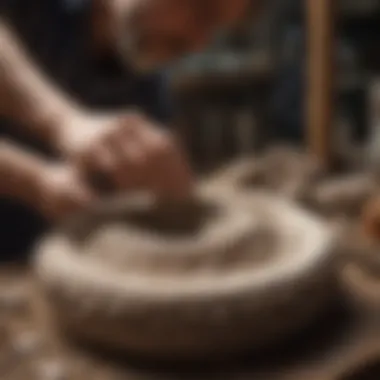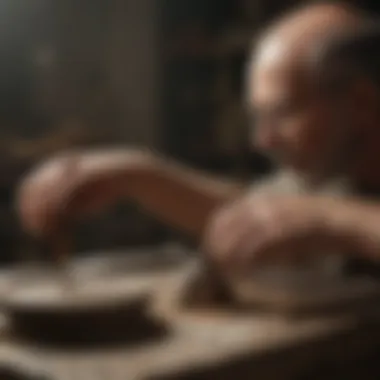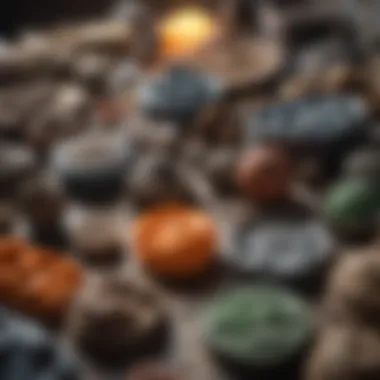Mastering the Craft of Mold Making: An In-Depth Guide for Artisans


Rock and Fossil Identification
When delving into the world of mold making, understanding the properties of rocks and fossils becomes essential. Different types of rocks and fossils each have unique characteristics that distinguish them from one another. By examining these features, such as color, texture, and composition, one can gain valuable insights into the materials they are working with. Utilizing specialized tools for identification can further aid in distinguishing between various rock types and fossils, ensuring precision in the mold-making process.
Understanding the Fundamentals of Mold Making
When it comes to mastering the art of mold making, understanding the fundamentals is crucial. This section serves as the backbone of the entire process, providing a solid foundation for novices and experts alike. By delving deep into the core principles of mold making, readers will grasp the essence of this intricate craft. From the significance of precision to the various materials and tools involved, this section sets the stage for a comprehensive exploration of mold making.
Introduction to Mold Making
Defining molds and their uses
Molds are fundamental in the art of replication, serving as the vehicle through which intricate details are captured and reproduced. Understanding the nuances of molds and their applications is key to achieving accurate and high-quality results in mold making. Whether it's for sculpting, casting, or prototyping, molds play a pivotal role in creating replicas of original works. The precision and intricacy of defining molds ensure that every contour and texture is faithfully replicated, making them a popular choice among artisans aiming for perfection. However, the laborious process of creating molds from scratch may pose challenges in terms of time and effort, requiring artisans to strike a balance between detail and efficiency.
Exploring the importance of precision
Precision is the cornerstone of mold making, dictating the fidelity and accuracy of the final cast. Achieving precision in mold making involves meticulous attention to detail and strategic planning to minimize errors. The importance of precision lies in its ability to capture the finest nuances of the original model, resulting in flawless reproductions that stay true to the artist's vision. However, maintaining high precision throughout the mold making process requires expertise and finesse, as even minor deviations can impact the overall quality of the final product. Overcoming challenges related to precision demands a blend of technical skill and artistic sensibility, ensuring that every mold created is a testament to the artisan's craftsmanship.
Materials for Mold Making
Silicone molds
Silicone molds have gained popularity for their versatility and durability in mold making. These molds are known for their flexibility, allowing artisans to easily demold intricate shapes without damage. The resilience of silicone molds makes them an ideal choice for capturing fine details and textures, ensuring that the final cast retains the essence of the original model. Despite their advantages, silicone molds may exhibit drawbacks such as higher material costs and limited reusability, prompting artisans to weigh the benefits against the expenses involved.
Plaster molds
Plaster molds have long been favored for their affordability and ease of use in mold making. These molds offer a cost-effective solution for artisans seeking to replicate simple shapes and forms with minimal complexity. The porous nature of plaster molds allows for efficient casting and drying processes, making them ideal for quick production turnaround. However, the fragility of plaster molds and their limited lifespan raise concerns regarding long-term usage and repeated casting, necessitating careful handling and maintenance to ensure consistent results.
Rubber molds
Rubber molds stand out for their durability and flexibility in mold making applications. These molds can withstand multiple casting cycles without losing their shape or integrity, making them a reliable choice for mass production. The elasticity of rubber molds facilitates easy demolding, enhancing the efficiency of the mold making process. Despite their resilience, rubber molds may pose challenges in terms of material selection and compatibility with certain casting materials, requiring artisans to carefully assess their suitability for specific projects.
Tools Required for Mold Making
Mixing containers
Mixing containers play a crucial role in ensuring the precise measurement and blending of mold-making materials. These containers are designed to withstand the chemical reactions involved in mold making, providing a safe and controlled environment for mixing. The transparency of mixing containers allows artisans to monitor the consistency and homogeneity of the materials, ensuring uniformity in the final mold. However, selecting the appropriate mixing container size and material composition is essential to prevent contamination and ensure optimal curing conditions.


Measuring tools
Accurate measurement is essential in mold making to maintain consistency and quality in the final product. Measuring tools such as graduated cylinders, scales, and calipers enable artisans to calibrate the exact proportions of mold-making materials, minimizing wastage and ensuring precision. The use of measuring tools enhances the reproducibility of molds, facilitating the creation of multiple casts with uniform dimensions and details. However, the calibration and maintenance of measuring tools are critical to their effectiveness, requiring regular checks and adjustments to uphold quality standards.
Release agents
Release agents serve as a protective barrier between the mold and casting material, preventing adherence and facilitating clean demolding. These agents create a non-stick surface that allows casts to be easily removed from the mold without damage. The selection of the appropriate release agent depends on factors such as the mold material and casting medium used, with compatibility playing a crucial role in ensuring successful demolding. While release agents enhance the efficiency of the mold making process, improper application or excessive use may result in surface defects and quality issues, necessitating careful consideration in their usage.
Step-by-Step Guide to Creating a Mold
Creating a mold is a fundamental aspect of the mold-making process, providing the foundation on which the entire project rests. The step-by-step guide outlined in this article offers a comprehensive overview of the intricate process involved in creating molds. From preparing the model to curing and demolding, each step is crucial in ensuring the successful replication of the desired object.
Preparing the Model
Cleaning the model
When embarking on mold making, ensuring the model is clean is paramount to the final result's quality. Cleaning the model involves meticulous attention to detail, removing any dust, debris, or imperfections that could affect the mold's integrity. A clean model serves as the base for a precise and accurate mold, reducing the risk of imperfections in the final cast. Utilizing gentle cleaning methods tailored to the specific material of the model is essential to maintain its shape and surface texture.
Securing the model
Securing the model in place is another critical step in the mold-making process. Properly securing the model ensures that it remains stable and centered during the molding material application. This step guarantees that the mold captures the exact details and contours of the model without any shifts or distortions. Using techniques such as anchoring the model to a base or employing support structures enhances the overall stability during the molding process, contributing to the mold's accuracy and fidelity.
Applying Mold Making Materials
Mixing the mold-making material
The meticulous mixing of mold-making material is a crucial element in achieving the desired mold. Consistency in mixing ensures uniform properties throughout the material, crucial for mold fidelity and durability. The correct mixture ratio, thorough blending, and elimination of air bubbles are essential aspects to consider when preparing the mold-making material. Attention to detail during this step directly impacts the mold's quality, strength, and overall effectiveness.
Pouring the material over the model
The process of pouring the mold-making material over the model requires precision and skill to achieve optimal results. A uniform and controlled pour ensures complete coverage of the model, capturing all intricate details effectively. Employing techniques such as slow pouring and steady movement minimizes the risk of air entrapment and ensures proper material distribution. Precision pouring plays a significant role in determining the mold's integrity and functionality, yielding a high-quality, accurate mold suitable for various applications.
Curing and Demolding
Allowing the mold to cure
Allowing the mold sufficient time to cure is essential for its structural integrity and longevity. Proper curing conditions, such as ideal temperature and humidity levels, contribute to the mold's strength and durability. This crucial step facilitates the solidification of the mold-making material, ensuring it can withstand subsequent use and manipulation effectively. Patience during the curing process is key to achieving a well-developed, resilient mold ready for demolding.
Removing the mold from the model


The final step of demolding requires precision and care to extract the mold from the model successfully. Gentle handling and strategic maneuvers help release the mold without damaging either the mold or the original model. Techniques such as gradual detachment and strategic application of pressure aid in separating the two components smoothly. Proper demolding preserves the integrity of the mold and prepares it for its intended purpose, whether for artistic creations, industrial applications, or restoration endeavors.
Advanced Techniques and Considerations
In the realm of mold making, advanced techniques and considerations play a pivotal role in elevating the craft to a higher level of precision and complexity. These aspects are vital in ensuring the successful creation of intricate and high-quality molds that meet the exacting standards of artisans and enthusiasts alike. By delving into advanced techniques, artisans can push the boundaries of their creativity and achieve molds with greater intricacy and detail.
One of the key benefits of incorporating advanced techniques into mold making is the ability to create complex molds that accurately capture the smallest details and nuances of a model. This level of precision is especially crucial in industries such as art, design, and prototyping. Moreover, considering advanced techniques opens up a world of creative possibilities, allowing artisans to experiment with innovative mold-making methods and materials to achieve stunning results.
Furthermore, the careful consideration of advanced techniques ensures that artisans can navigate challenges effectively, troubleshoot issues, and address intricacies specific to complex mold designs. By mastering advanced techniques, artisans can enhance their skills, confidence, and ultimately, the quality of their final mold creations.
Creating Complex Molds
Multi-part Molds
Multi-part molds present a specific aspect of mold making that is essential for capturing intricate shapes and forms with multiple undercuts. These molds consist of several interlocking sections that, when combined, create a seamless mold. The key characteristic of multi-part molds lies in their ability to accommodate complex shapes that a single-piece mold cannot cover.
The advantage of multi-part molds lies in their versatility and capability to reproduce highly detailed models accurately. This makes them a popular choice for artisans working on projects that require precise replication of intricate designs. However, managing multi-part molds requires meticulous alignment and attention to detail to ensure seamless integration and precise casting.
Cut Molds
Cut molds represent another valuable technique in the realm of mold making, particularly useful for generating molds for symmetrical objects or pieces with distinct sections. The key characteristic of cut molds is their ability to facilitate easier demolding by splitting the mold into separate parts. This aspect streamlines the demolding process and simplifies the extraction of the casted object.
Opting for cut molds can be beneficial when dealing with intricate models that necessitate a strategic approach to demolding. The unique feature of cut molds lies in their ability to enhance efficiency and accuracy during the demolding process. However, there may be a slight drawback in terms of complexity during the mold creation phase, as precision is crucial for aligning and rejoining the separated mold sections effectively.
Troubleshooting Common Issues
Avoiding Air Bubbles
The occurrence of air bubbles in molds can impede the quality of the final casted object, leading to imperfections and structural weaknesses. Thus, avoiding air bubbles stands as a crucial aspect in mold making to ensure flawless results. The key characteristic of this technique involves employing proper mixing techniques, degassing methods, and ensuring a controlled pouring process to minimize air entrapment.
This approach is highly beneficial in maintaining the integrity and detail of the mold, resulting in flawless casts without imperfections caused by trapped air. The unique feature of air bubble avoidance lies in its ability to enhance the overall quality of molds and casts, elevating the artisan's work to a professional standard. However, precision and meticulous attention are required to implement this technique effectively.
Preventing Undercuts
Preventing undercuts constitutes a fundamental consideration in mold making to facilitate smooth demolding and maintain the integrity of the mold and casted object. The key characteristic of addressing undercuts involves strategic mold design and careful model preparation to eliminate any sections that would obstruct the demolding process.
This technique is advantageous in streamlining the demolding process and ensuring that the final casted object emerges smoothly and without damage. The unique feature of preventing undercuts lies in its ability to enhance efficiency, reduce production time, and minimize the risk of damaging the mold during extraction. However, particular attention must be paid during the model design phase to account for undercuts effectively.
Tips for Enhancing Mold Durability


Reinforcing Mold Seams
Reinforcing mold seams plays a critical role in enhancing the longevity and durability of molds, especially when dealing with complex shapes or large-scale projects. The key characteristic of reinforcing mold seams involves adding additional support or material along seams to prevent flexing and ensure structural integrity.
The advantage of reinforcing mold seams lies in the enhanced stability and resistance to wear and tear, extending the life cycle of the mold and allowing for repeated use without compromising quality. This technique is particularly beneficial for molds subjected to frequent use or handling, providing added robustness and reliability. However, the additional material or support may slightly increase production time and material costs.
Proper Storage
Proper storage of molds is essential in preserving their quality and prolonging their usability over time. The key characteristic of proper mold storage includes maintaining a clean and dry environment, protecting molds from dust and debris, and storing them in a temperature-controlled setting to prevent moisture buildup or mold deformation.
Choosing proper storage methods ensures that molds retain their shape, detail, and functionality for an extended period, enabling artisans to reuse them for multiple projects without concerns about degradation or damage. The unique feature of proper storage lies in its role in safeguarding the artisan's investment in mold making materials and efforts, providing peace of mind and long-term usability. However, establishing a dedicated storage system may require initial organization and planning to optimize space and accessibility.
Exploring Applications of Mold Making
In the realm of mold making, exploring different applications is crucial for understanding the versatility and potential of this craft. This section sheds light on the diverse uses of mold making techniques, showcasing how they are utilized across various industries and artistic endeavors. By delving into the applications of mold making, readers can grasp the practical implications and creative possibilities that stem from mastering this art.
Artistic Creations
Sculptures
Sculptures hold a prominent place in the world of art, and mold making plays a vital role in their replication and production. The intricate details and textures found in sculptures can be accurately reproduced through mold making processes, allowing artists to create multiple copies with precision and consistency. The key characteristic that makes sculptures an ideal choice for mold making is their three-dimensional nature, which lends itself well to mold replication. While the process of creating molds for sculptures can be labor-intensive, the advantage lies in the ability to replicate intricate designs with ease, making it a popular technique for artists looking to produce multiple sculptures.
Replicas
Replicas serve as exact copies of original artworks or objects, preserving their aesthetic and historical value. Mold making enables the replication of replicas with exceptional accuracy, capturing every detail and intricacy of the original piece. The unique feature of replicas lies in their ability to be mass-produced while maintaining the authenticity of the original artifact. One of the advantages of utilizing replicas in mold making is the conservation of cultural heritage, allowing rare or fragile artifacts to be reproduced and disseminated for educational or decorative purposes.
Industrial Uses
Mass production
Mass production relies heavily on efficient and cost-effective manufacturing processes, with mold making playing a pivotal role in streamlining production cycles. The key characteristic of mass production lies in the ability to produce large quantities of identical products in a short timeframe, meeting consumer demand effectively. Mold making facilitates the replication of complex shapes and designs, ensuring consistency across a high volume of manufactured goods. While mass production offers scalability and economic advantages, careful consideration must be given to design and material selection to optimize the mold making process.
Prototyping
Prototyping involves creating preliminary versions of products to test their design, function, and usability before full-scale production. Mold making allows for the rapid and accurate replication of prototypes, enabling manufacturers to assess and refine product concepts efficiently. The unique feature of prototyping lies in its iterative nature, allowing for multiple design iterations without incurring significant costs. The advantage of utilizing prototypes in mold making is the ability to identify and resolve potential issues early in the production process, ultimately leading to improved product quality and customer satisfaction.
Restoration and Conservation
Preserving artifacts
The preservation of artifacts is essential for maintaining cultural heritage and historical significance, and mold making serves as a valuable tool in this endeavor. By creating molds of delicate or deteriorating artifacts, conservationists can safeguard their form and details for future generations. The key characteristic of preserving artifacts through mold making is the non-invasive nature of the process, ensuring minimal impact on the original object. While preserving artifacts through molds allows for accurate reproductions, careful attention must be paid to materials and techniques to uphold the integrity of the original piece.
Repairing damaged pieces
In the realm of restoration, repairing damaged artifacts or artworks requires intricate craftsmanship and attention to detail. Mold making provides a solution for recreating missing or damaged parts of objects, allowing conservators to restore them to their original form. The unique feature of repairing damaged pieces through mold making is the ability to seamlessly integrate new components with existing objects, ensuring cohesive restoration outcomes. While the advantages of using molds for repairing damaged pieces include precise duplication and restoration, challenges may arise in matching colors and textures accurately, requiring skillful execution and expertise.







